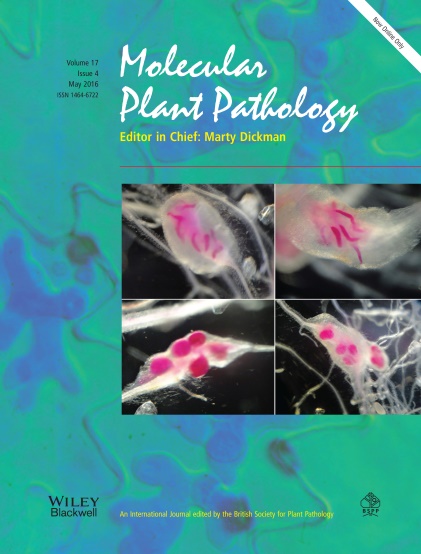分享到
Thiamine-induced priming against root-knot nematode infection in rice involves lignification and hydrogen peroxide generation
Thiamine (vitamin B1, VB1) can act as a plant defence trigger, or priming agent, leading to a rapid counterattack on pathogen invasion. Previous studies have verified that thiamine is a systemic, broad-spectrum, long-lasting resistance inducer to defense against fungi, bacteria and viruses in multiple plant species. Although thiamine has been found to induce resistance to different pathogens, the molecular mechanisms underlying this have not been completely elucidated, and nematode infection has not been tested previously.
Recently, scientists at State Key Laboratory for Biology of Plant Diseases and Insect Pests, Institute of Plant Protection of Chinese Academy of Agricultural Sciences (CAAS) have published a cover paper about VB1 induced priming against root-knot nematode infection in rice in Molecular Plant Pathology.

Effect of thiamine soaking on nematode viability and infectivity
This study evaluated the priming effect of thiamine on rice (Oryza sativa cv. Nipponbare) and its activity against root-knot nematode (Meloidogyne graminicola) infection. It was found that thiamine treatment and subsequent nematode inoculation activated hydrogen peroxide (H2O2) accumulation and lignin deposition in plant roots, and this correlated with enhanced transcription of OsPAL1 and OsC4H, two genes involved in the phenylpropanoid pathway. It was also found that number of nematodes in rice roots was slightly but significantly reduced, and the development of the nematodes was delayed, whereas no direct toxic effects of VB1 on nematode viability and infectivity were observed. The combined application of thiamine with L-2-aminooxy-3-phenylpropionic acid (AOPP), an inhibitor of phenylalanine ammonia-lyase (PAL), significantly hampered the VB1-priming capacity. These findings above indicate that thiamine induced priming in rice involves H2O2 and phenylpropanoid mediated lignin production, which hampers nematode infection. Further cellular and molecular studies on the mechanism of thiamine-induced defence will be useful for the development of novel nematode control strategies.
More details are available on the bellow links:
http://onlinelibrary.wiley.com/doi/10.1111/mpp.12316/pdf
Recently, scientists at State Key Laboratory for Biology of Plant Diseases and Insect Pests, Institute of Plant Protection of Chinese Academy of Agricultural Sciences (CAAS) have published a cover paper about VB1 induced priming against root-knot nematode infection in rice in Molecular Plant Pathology.

Effect of thiamine soaking on nematode viability and infectivity
This study evaluated the priming effect of thiamine on rice (Oryza sativa cv. Nipponbare) and its activity against root-knot nematode (Meloidogyne graminicola) infection. It was found that thiamine treatment and subsequent nematode inoculation activated hydrogen peroxide (H2O2) accumulation and lignin deposition in plant roots, and this correlated with enhanced transcription of OsPAL1 and OsC4H, two genes involved in the phenylpropanoid pathway. It was also found that number of nematodes in rice roots was slightly but significantly reduced, and the development of the nematodes was delayed, whereas no direct toxic effects of VB1 on nematode viability and infectivity were observed. The combined application of thiamine with L-2-aminooxy-3-phenylpropionic acid (AOPP), an inhibitor of phenylalanine ammonia-lyase (PAL), significantly hampered the VB1-priming capacity. These findings above indicate that thiamine induced priming in rice involves H2O2 and phenylpropanoid mediated lignin production, which hampers nematode infection. Further cellular and molecular studies on the mechanism of thiamine-induced defence will be useful for the development of novel nematode control strategies.
More details are available on the bellow links:
http://onlinelibrary.wiley.com/doi/10.1111/mpp.12316/pdf
By Wenkun Huang
wkhuang@ippcaas.cn
wkhuang@ippcaas.cn
Latest News
-
 Apr 18, 2024Opening Ceremony of the Training Workshop on Wheat Head Scab Resistance Breeding and Pest Control in Africa Held in CAAS
Apr 18, 2024Opening Ceremony of the Training Workshop on Wheat Head Scab Resistance Breeding and Pest Control in Africa Held in CAAS -
 Apr 03, 2024IPPCAAS Co-organized the Training Workshop on Management and Application of Biopesticides in Nepal
Apr 03, 2024IPPCAAS Co-organized the Training Workshop on Management and Application of Biopesticides in Nepal -
 Mar 28, 2024Delegation from the School of Agriculture and Food Science of University College Dublin, Ireland Visit to IAS, CAAS
Mar 28, 2024Delegation from the School of Agriculture and Food Science of University College Dublin, Ireland Visit to IAS, CAAS -
 Mar 25, 2024Director of World Food Prize Foundation visited GSCAAS
Mar 25, 2024Director of World Food Prize Foundation visited GSCAAS -
 Mar 20, 2024Institute of Crop Sciences (ICS) and Syngenta Group Global Seeds Advance Collaborative Research in the Seed Industry
Mar 20, 2024Institute of Crop Sciences (ICS) and Syngenta Group Global Seeds Advance Collaborative Research in the Seed Industry
